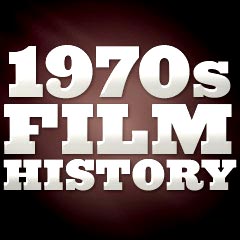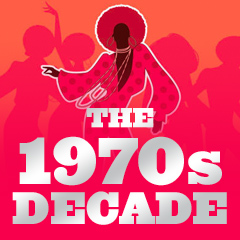|
John Cassavetes - Independent Auteur
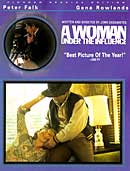 After his first feature film, the crudely-improvised Shadows (1959),
independent filmmaker John Cassavetes, dubbed "the father of American independent cinema", turned to studio films for a few
years, but then after finding studio films too restrictive, he resumed
low-budget, independent filmmaking stretching into the 70s with his highly
individualistic style and realistic, stark cinema verité
(with unscripted and often inaudible dialogue, poor lighting, and improvisational character studies in overlong,
amateurish and ragged films made with a hand-held camera). He used his
actor's salary (in films like The Dirty Dozen (1967) and Rosemary's
Baby (1968)) to finance his own film productions, such as: After his first feature film, the crudely-improvised Shadows (1959),
independent filmmaker John Cassavetes, dubbed "the father of American independent cinema", turned to studio films for a few
years, but then after finding studio films too restrictive, he resumed
low-budget, independent filmmaking stretching into the 70s with his highly
individualistic style and realistic, stark cinema verité
(with unscripted and often inaudible dialogue, poor lighting, and improvisational character studies in overlong,
amateurish and ragged films made with a hand-held camera). He used his
actor's salary (in films like The Dirty Dozen (1967) and Rosemary's
Baby (1968)) to finance his own film productions, such as:
- A Child is Waiting (1963)
- Faces (1968), his fourth feature (made in 16 mm) that began filming in 1966 - an over two-hour long study of infidelity in which he
cast his wife Gena Rowlands as one of the lead characters, a high-class call girl named Jeannie Rapp; the film has been noted as the first independently-made and distributed American film to reach mainstream audiences
- Husbands (1970)
- Minnie and Moskowitz (1971)
- A Woman Under the Influence (1974), one of his
most brilliant films (for which he was nominated as Best Director) with
Best Actress-nominated Gena Rowlands in the lead role as mood-swinging, lower middle-class
housewife Mabel Longhetti whose increasing madness led to her institutionalization
- The Killing of a Chinese Bookie (1976)
- Gloria (1980)
The 'Detective' and Crime Film Genre: Right-Wing
Cop Action Films
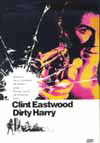 Following
the success of Bullitt (1968), a cycle of "lone wolf" or "rogue
cop" detective
films appeared during times of rising crime, most prominently
Don Siegel's bold Dirty
Harry (1971) with emerging star Clint Eastwood as maverick,
rule-breaking, .44 Magnum-wielding San Francisco cop Detective "Dirty"
Harry
Callahan. The entire film consisted of his dogged pursuit of psychopathic
serial killer Scorpio (Andy Robinson) in the city, based upon the
exploits of the real-life Zodiac Killer. 'Dirty Harry' became famous
for his opening signature line toward a black bank robber (Albert
Popwell) wounded on the ground who was tempted to shoot him - and
he successfully bluffed him: "I
know what you're thinkin'. 'Did he fire six shots or only five?'
...You've got to ask yourself one question: 'Do I feel lucky?' Well,
do ya punk?" Following
the success of Bullitt (1968), a cycle of "lone wolf" or "rogue
cop" detective
films appeared during times of rising crime, most prominently
Don Siegel's bold Dirty
Harry (1971) with emerging star Clint Eastwood as maverick,
rule-breaking, .44 Magnum-wielding San Francisco cop Detective "Dirty"
Harry
Callahan. The entire film consisted of his dogged pursuit of psychopathic
serial killer Scorpio (Andy Robinson) in the city, based upon the
exploits of the real-life Zodiac Killer. 'Dirty Harry' became famous
for his opening signature line toward a black bank robber (Albert
Popwell) wounded on the ground who was tempted to shoot him - and
he successfully bluffed him: "I
know what you're thinkin'. 'Did he fire six shots or only five?'
...You've got to ask yourself one question: 'Do I feel lucky?' Well,
do ya punk?"
Throughout his impassioned, unrestrained and fanatical
search for the killer, the heavy-handed and embittered Callahan was
reprimanded by his authoritarian, bureaucratic superiors (the Mayor,
the DA, etc.) for not following 'the book' and for illegally overstepping
his procedural bounds by ignoring victims' rights. By film's end after
killing Scorpio, the heroic Dirty Harry threw away his badge. Critic
Pauline Kael labeled the film "fascist" and "deeply
immoral" for its strident political views, since the film took
a non-PC political stance - the POV of crime victims (rather than criminals)
by its endorsement of autonomous vigilantism.
Four successors to Dirty Harry
(1971) that starred Eastwood were:
- Magnum Force (1973), d. Ted Post,
more violent but less stylistic, with Harry taking on
an avenging, black-clad police death squad involved in vigilantism
- The Enforcer (1976), d. James
Fargo
- Sudden
Impact (1983) - director/star Clint Eastwood's reprising
of his formulaic role as an independent cop
- The Dead Pool (1988), d. Buddy Van Horn
Similar to "Dirty Harry," Charles Bronson (as NYC architect
Paul Kersey) sought vengeance as an angry, emotionless vigilante in
Michael Winner's controversial thriller Death Wish (1974). Kersey was not present in his Manhattan
apartment when his wife Joanna (Hope Lange) was lethally assaulted
by hoodlums (and his daughter Carol was raped at the hands of one of
the thugs, portrayed by Jeff Goldblum). Kersey sought extra-legal street
justice for himself when the impotent police failed to solve the case,
and he began to take pleasure in punishing muggers and other criminals,
sometimes by posing as a vulnerable target but in fact setting up a predatory
attack. Kersey soon found himself the target of NYPD Lt. Frank Ochoa
(Vincent Gardenia) who was in pursuit of the vigilante responsible for
numerous killings.
The original film
led to three similar sequels in the 1980s:
- Death Wish 2 (1982)
- Death
Wish 3 (1985)
- Death Wish 4: The Crackdown (1987)
The Start of Clint Eastwood's Growing Influence:
Clint Eastwood
was transformed when he made an impressive debut as director in the
psychologically-shocking, suspenseful, and violent Play
Misty for Me (1971) about
a KRML Radio disc jockey threatened by an obsessed fan who kept calling
for her favorite song. He also starred as easy-going trucker and bare-knuckle
fighter Philo Beddoe who was upstaged by an orangutan named Clyde in
the C&W
comedy Every
Which Way But Loose (1978). Its success led to the inevitable
sequel Any Which
Way You Can (1980). Eastwood also starred in Siegel's suspenseful
prison break-out film Escape From Alcatraz (1979). He also
began directing, producing, and acting in westerns in the 70s
- a career move that he maintained into the 90s, during a time
when most directors avoided the unpopular genre:
- High Plains Drifter (1973)
- The Outlaw Josey Wales (1976)
- Bronco Billy (1980)
- Pale Rider (1985)
- Unforgiven (1992)
Urban Crime Thrillers, Militancy and Graphic Violence:
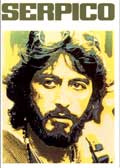 Graphic,
realisitc violence in urban America was a major element of a number
of 70s dramatic films starring police characters. The urban crime thriller
based on a true story was Best Director-winning William Friedkin's
Best Picture winner The
French Connection (1971) echoed the brutal vigilante mentality
of Eastwood's films. Two lower-middle-class tough cops in New York
City - a good cop/bad cop partnership: racist, abusive, rule-breaking
and hard-charging Jimmy "Popeye" Doyle (Gene Hackman) and his partner
Buddy "Cloudy" Russo (Roy Scheider), were on the trail of criminals
throughout the urban area, and happened to see a suspicious connection
between a lowly Brooklyn luncheonette owner Sal Boca (Tony Lo Bianco)
and heroin drug dealers Joel Weinstock (Harold Gary) and French master-mind
Alain "Frog One" Charnier (Fernando Rey). The drugs were to be smuggled
inside the frame of a luxury car shipped from Europe. The film's
most memorable sequence was Popeye's car pursuit of Charnier's assassin
Pierre Nicoli (Marcel Bouzzuffi) in an overhead elevated subway train.
The downbeat, ambiguous and unhappy ending culminated in the friendly-fire
killing of a cop by Doyle during an unsuccessful pursuit (and escape)
of Charnier within an abandoned industrial building on Wards Island. Graphic,
realisitc violence in urban America was a major element of a number
of 70s dramatic films starring police characters. The urban crime thriller
based on a true story was Best Director-winning William Friedkin's
Best Picture winner The
French Connection (1971) echoed the brutal vigilante mentality
of Eastwood's films. Two lower-middle-class tough cops in New York
City - a good cop/bad cop partnership: racist, abusive, rule-breaking
and hard-charging Jimmy "Popeye" Doyle (Gene Hackman) and his partner
Buddy "Cloudy" Russo (Roy Scheider), were on the trail of criminals
throughout the urban area, and happened to see a suspicious connection
between a lowly Brooklyn luncheonette owner Sal Boca (Tony Lo Bianco)
and heroin drug dealers Joel Weinstock (Harold Gary) and French master-mind
Alain "Frog One" Charnier (Fernando Rey). The drugs were to be smuggled
inside the frame of a luxury car shipped from Europe. The film's
most memorable sequence was Popeye's car pursuit of Charnier's assassin
Pierre Nicoli (Marcel Bouzzuffi) in an overhead elevated subway train.
The downbeat, ambiguous and unhappy ending culminated in the friendly-fire
killing of a cop by Doyle during an unsuccessful pursuit (and escape)
of Charnier within an abandoned industrial building on Wards Island.
Its sequel by director John Frankenheimer - French
Connection II (1975) brought back Gene Hackman as the tough-nosed
NY cop still in pursuit of international heroin dealers in Marseilles.
Sidney Lumet's Serpico (1973), based on the book by Peter Maas,
was the true story of dedicated, honest New York cop Frank Serpico (Al
Pacino) (nicknamed Paco) who fought against vast corruption in the city
by blowing the whistle on others who took payoffs. William Friedkin also
directed Pacino in Cruising (1980) as an undercover cop investigating
grisly murders in NY's gay community. The headlines of a fact-based 1972
story about a defiant folk-hero - a bi-sexual bank robber in a desperate
hostage situation, became the basis for Sidney Lumet's Dog Day Afternoon
(1975). Its unlikely story pitted nothing-to-lose hustler Sonny
Wortzick (Al Pacino again) in a failed NYC bank raid against the authorities
- to fund his boyfriend's (Chris Sarandon) sex change operation.
Sam Peckinpah's ultra-violent Straw Dogs (1971)
provoked controversy with charges of gratuitous violence, and The
Getaway (1972) with hard-bitten convict Steve McQueen in the
lead role, was another typically-violent film. Michael Caine starred
in the UK crime film Get Carter (1971) as the title character
- a London gangster trying to avenge his murdered brother.
Sydney Pollack's suspenseful political thriller Three Days of
the Condor (1975) involved a researcher (Robert Redford) who
discovered all of his co-workers dead after lunch - and a conspiracy
within the CIA, and decided the only way to survive was to give
his story to The New York
Times.
Walter Hill's gang film set in a surrealistic New York
City entitled The Warriors (1979) was worrisome for its instigation
of violent gang warfare and feuding. Actual gang violence, including
shootings, rumbles, and stabbings occurred during some showings
of The Warriors (1979) and Michael
Pressman's Boulevard Nights
(1979), about East LA gang life in a Latino barrio.
The Continuing James Bond Series:
There were five additional entries in the Bond series
in the decade, with a new actor (Roger Moore) in the role of agent
007 beginning in 1973:
- Diamonds Are Forever (1971), the 7th Bond film
in the series, again with Sean Connery as Bond (his 6th appearance,
and last Bond film for 12 years), and Jill St. John and Lana Wood as
the 'Bond Girls,' and Charles Gray as the villain (Ernst Stavro Blofeld);
directed by Guy Hamilton
- Live and Let Die (1973), the 8th film, and the
first with Roger Moore as the special agent; fast-paced, entertaining,
and violent; also with Jane Seymour as the 'Bond Girl' and Yaphet Kotto
as the villain, Mr. Big [Moore was selected for the role of Bond because
of two previous roles: as Robin Hood-like Simon Templar in the mid-1960s
British TV series The Saint, based on the Leslie Charteris books,
and as international playboy Lord Brett Sinclair in the early 70s British
TV series The Persuaders]
- The Man With the Golden Gun (1974), the 9th
film, again with Roger Moore; also with Britt Ekland and Maud Adams
as the 'Bond Girls' and Christopher Lee as the villain, Scaramanga;
directed by Guy Hamilton
- The Spy Who Loved Me (1977), the 10th film,
and Roger Moore's third Bond film; with Barbara Bach as the 'Bond Girl',
Curt Jurgens as the villain (Karl Stromberg) and Richard Kiel as Jaws
- Moonraker (1979),
the 11th film, an expensive one with an outer-space theme, also
with Roger Moore; with Lois Chiles as the 'Bond Girl', Michel
Lonsdale as the villain (Drax) and Richard Kiel as the menacing
'Jaws'
African American Film-Makers in the Early 1970s:
Black actors and film-makers had always played a part
in early American film history, as either stereotypical or typecast
characters (maids or mammy figures, porters, comic-relief characters,
"Uncle Toms," etc.), or in the films of black film-makers such as producer/director
Oscar Micheaux (with his low-budget, usually all-black "race films")
and others. In the 1950s and 1960s, Dorothy Dandridge (the first African
American screen siren), Harry Belafonte (the first African American
male sex symbol), and Sidney Poitier (the first black superstar) became
Hollywood's black superstars. Roles for blacks began to slowly increase
in scope and change with the advent of concurrent social changes. A
number of black athletes entered the cinematic arena to perform in
generic action films, including O.J. Simpson, Jim Brown, and Fred Williamson.
African-American film-makers also began to make inroads
in the late 60s, beginning with Gordon Parks Sr.'s brilliantly-photographed
first directorial film The
Learning Tree (1969) - an autobiographical account (or coming-of-age
film) of a boy growing up black in 1920s Kansas, and realizing the
consequences of race. [Note: Parks was a former
photojournalist with Life Magazine, and the first black mainstream
Hollywood director. Parks'
film was a major milestone - he was the first African-American film-maker
to direct a motion picture that was released by a major US studio.]
Independent film actor/director/writer Melvin Van Peebles
was another of the earliest African Americans to work within the Hollywood
studio system. Peebles' second film (and first Hollywood film) was
the message movie-comedy Watermelon Man (1970), starring Godfrey
Cambridge in a dual role as a Los Angeles insurance agent in 1968 named
Jeff Gerber. Originally a suburban white racist and physical fitness
enthusiast who became black overnight, he began to experience the hostility
toward blacks in America.
Then came actor/director Ossie
Davis' crime-comedy Cotton
Comes to Harlem (1970), an action, police detective and buddy
film. Two plainclothes Harlem police detectives: Coffin Ed (Raymond
St. Jacques) and Grave Digger Jones (Godfrey Cambridge), sought to
investigate a fraudulent fund-raising scam on poor Harlem blacks
known as "Back to Africa," run by corrupt black nationalist preacher
Reverend Deke O'Malley (Calvin Lockhart). The illicit funds were
hidden in a bale of cotton. The film ultimately
became the precursor to other popular buddy-cop films, such as
Lethal Weapon (1987) and
its franchise
series (1987-1998), and a series of Bad Boys (1995) films.
Director Mark Warren's Come
Back Charleston Blue (1972) about a vigilante
named Charleston Blue in Harlem, served as the sequel to Cotton
Comes to Harlem.
Actor Sidney Poitier directed the
revisionist western Buck
and the Preacher (1972), his first Hollywood film. The title
characters were: wagon-master Buck (Poitier) who led former African-American
slaves (now aspiring homesteaders) from the South to the frontier
after the Civil War to become land-owners and farmers. He was partnered
with con-man Preacher (Harry Belafonte) to combat bands of white
rogue agents led by villainous Deshay (Cameron Mitchell) who
attacked the wagon trains and threatened to return the black settlers
back to the South.
The Rise of Action Blaxploitation Films:
 In
the early 70s, a series of so-called 'blaxploitation' films emerged,
either as a reflection of black anger at whites, as potential empowerment
for blacks, or as a new marketing angle from Hollywood. Melvin Van Peebles
abandoned his contract at Columbia to direct the X-rated, confrontational
cult film Sweet
Sweetback's Baadasssss Song (1971) - the
first true blaxploitation film. It was specifically designed to upset white
audiences (advertised with "Rated X by an All-White
Jury"),
with Peebles himself playing the part of the sex-hungry, violent
anti-hero - a black prostitute and fugitive on the run from racist cops. In
the early 70s, a series of so-called 'blaxploitation' films emerged,
either as a reflection of black anger at whites, as potential empowerment
for blacks, or as a new marketing angle from Hollywood. Melvin Van Peebles
abandoned his contract at Columbia to direct the X-rated, confrontational
cult film Sweet
Sweetback's Baadasssss Song (1971) - the
first true blaxploitation film. It was specifically designed to upset white
audiences (advertised with "Rated X by an All-White
Jury"),
with Peebles himself playing the part of the sex-hungry, violent
anti-hero - a black prostitute and fugitive on the run from racist cops.
The successful
independent film (budgeted at $500,000), with a gospel soundtrack by
Earth, Wind & Fire, was released by independent distributor Cinemation,
and aimed at urban black audiences, and began its run by playing in
only two theatres (in Atlanta and Detroit). It caused tremendous controversy
for its militancy, sex, anti-white sentiment, revenge-themes, and violence,
although it became one of the most important black American films of
the decade (eventually earning revenue of $10 million). Its most controversial
scene was the rape of the director's son Mario by a middle-aged prostitute.
[Note: Mario Van Peebles' film Baadasssss!
(2004) told the story of how his father, Melvin, contributed
to modern independent black filmmaking with his 1971 film.]
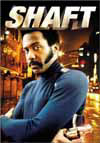 The
first major, commercial blaxploitation crime film with a black hero
appeared at the same time - the colorful, action-packed, slightly tongue-in-cheek
MGM film Shaft
(1971) - again by esteemed black director Gordon Parks
Sr. Shaft starred
Richard Roundtree as the ultra-hip, handsome police detective
John Shaft (the black version of Clint Eastwood's "Dirty
Harry" Callahan, and similar to the hard-boiled detectives
of the 1940s) who worked in Harlem against the Mafia. He was
hired by a Harlem racketeer to find the mobster's kidnapped
daughter, and became involved in a Harlem criminal gang war
between two opposing groups over drug trade. Shaft won
an Oscar for Isaac Hayes' memorable theme song for the title
credits of the film (proclaiming that Shaft was 'a private
dick who's a sex machine to all the chicks'). The film brought ‘blaxploitation’ cinema
to mainstream audiences, and emphasized a proud and tall black hero with
multiple bed partners who was effective against crime. It spawned two
lesser sequels: Shaft's
Big Score! (1972) and Shaft in Africa (1973), as
well as a TV series. The
first major, commercial blaxploitation crime film with a black hero
appeared at the same time - the colorful, action-packed, slightly tongue-in-cheek
MGM film Shaft
(1971) - again by esteemed black director Gordon Parks
Sr. Shaft starred
Richard Roundtree as the ultra-hip, handsome police detective
John Shaft (the black version of Clint Eastwood's "Dirty
Harry" Callahan, and similar to the hard-boiled detectives
of the 1940s) who worked in Harlem against the Mafia. He was
hired by a Harlem racketeer to find the mobster's kidnapped
daughter, and became involved in a Harlem criminal gang war
between two opposing groups over drug trade. Shaft won
an Oscar for Isaac Hayes' memorable theme song for the title
credits of the film (proclaiming that Shaft was 'a private
dick who's a sex machine to all the chicks'). The film brought ‘blaxploitation’ cinema
to mainstream audiences, and emphasized a proud and tall black hero with
multiple bed partners who was effective against crime. It spawned two
lesser sequels: Shaft's
Big Score! (1972) and Shaft in Africa (1973), as
well as a TV series.
The earliest 'blaxploitation' films featured smart-ass
'jive' dialogue, street obscenities, muscle-bound black heroes, brutal
action and fight scenes, car chases, gun play, some nudity, Afros and
snappy duds, and despicable villains. On the down side, the aspirations
of blacks were seen within the dregs of society in the inner city -
demeaning role models such as pimps, drug dealers, mobsters, hitmen
and super-sexual males without much intellectual acuity. Even some
black groups such as the NAACP and CORE created backlash by
opposing the militant, reprehensible exploitational black movies that
glorified negative stereotypes and reinforced white attitudes toward
black culture.
After the first few of these mostly B-films
hit the screens, many other lesser, formulaic, and sometimes edgier,
audacious "blaxploitation"
films with black actors in stereotypical film roles began to flood
the market - designed specifically for the newfound market of African-American
film audiences. Some of the films were
classic cult favorites, although others were low-budget, very poorly
made and of inferior quality, such as The Black 6 (1973) starring
six black NFL players who rode around as a motorcycle gang.
Starting in the early 1970s, over 200 major films
would be released by major and independent studios to profit
from the black movie-going audiences. In some cases because
of the small number of African-American actors, black athletic
superstars (Jim Brown, Rosie Grier, Fred Williamson, and Vida
Blue) and others (comedian Richard Pryor got his start in these
films as did Antonio Fargas) were recruited and cast in the
lead or supporting roles:
- Black Gunn (1972) - from Columbia Pictures,
an action flick starring Cleveland
Brown's fullback turned actor Jim Brown as Gunn - an LA nightclub owner
who sought revenge for the murder of his ex Vietnam Vet younger
brother Scott (Herb Jefferson Jr.) (involved with militant blacks
who robbed money from racist Mob gang members, led by boss Capelli
(Martin Landau))
- Blacula (1972) - R-rated
(for violence) - the first black
horror film, and directed by black filmmaker William
Crain, with an Afro-American spin on the entire vampire (Dracula)
series; the sequel was Scream Blacula Scream (1973); it set
the stage for other black horror films
in the 1970s, including
Ganja & Hess (1973), Abby (1974), Sugar Hill
(1974), Dr.
Black, Mr. Hyde (1976), and J.D.'s Revenge (1976)
- Hammer (1972) - the sports-themed film that
used ex-football player Fred Williamson's (who played for the Oakland
Raiders and Kansas City Chiefs) grid-iron nickname "Hammer" -
it was loaded with fight scenes featuring Williamson
as B.J. Hammer, a muscle-bound, side-burned dock worker and boxer,
who spouted an incredible line to his girlfriend Lois (Vonetta
McGee) about what he did when he first moved to the city: "I cut
my teeth playing big-time city games like Smack the Fag, Hump the
Whore and Dodge the Needle, so ain't no jive-time jelly-belly cat
gonna rip me off"
- The Harder They Come (1972), the first successful
film from Jamaica, starring Jimmy Cliff, and introducing reggae
music and Rastafarian culture to the US
- Hit Man (1972) - with Bernie Casey as enforcer
'hit man' Tyrone Tackett, featured lots of nudity including a
memorable sex scene with sexy porn star Gozelda (Pam Grier); this
blaxploitation classic was a modified adaptation of Ted Lewis'
novel Jack’s
Return Home that previously inspired the seminal
gangster film Get Carter (1972, UK)
- Slaughter (1972), from American Independent
Pictures (AIP), an excessively-violent glorification of Harlem
drug trafficking with Cleveland Browns running back Jim Brown in
the title role as an ex-Green Beret combating the Mob; followed
by the sequel Slaughter's Big Rip-Off (1973)
- Super Fly
(1972) - directed by Gordon Parks Jr., with
Ron O'Neal as a stylish, flashy-dressing, NYC cocaine pusher (and
user) named Youngblood Priest, who drove a "hog" vehicle
(Cadillac El Dorado) while out to complete
one last major underworld drug deal or score in Harlem before he
can "get out of the life" (in other words, go straight);
it turned out that 'dirty' cops led by the white deputy police commissioner
Riordan were using Priest as the middleman in ther drug dealings;
with a funky Curtis Mayfield score (a soundtrack that outgrossed
the film!) including the hit singles Super Fly, Pusherman and Freddie's
Dead; one of the best known of the blaxploitation films, it
inspired urban fashions (coke-spoon jewelry, perms, etc.)
as Shaft
(1971) had
done; it was remade as
Superfly (2018)
- Trouble Man (1972) - an action-crime drama
featuring actor Robert Hooks as "Mr. T." - described as "Cold Hard
Steel! He'll Give You Peace of Mind... Piece by Piece!" and "His
friends call him Mr. T. His enemies call for mercy!"- and with
memorable soundtrack by Marvin Gaye
- Black Caesar (1973), from writer/director
Larry Cohen, modeled after the Warners' gangster classic of 1931,
with Fred Williamson as Tommy Gibbs, who grew up to be a criminal
kingpin: "The Godfather of Harlem", and with a memorable James
Brown soundtrack (including "Down and Out in New York City"); followed
by sequel Hell Up in Harlem (1973)
- The Black 6 (1973), with lots of pro-football
stars as Vietnam Vets - members of a motorcycle gang, including "Mean" Joe
Greene, Carl Eller, Gene Washington, Willie Lanier, Ben Davidson
and Mercury Morris
- Hell Up in Harlem (1973),
AIP's sequel to Black Caesar (1973), again by writer/director
Larry Cohen, with the tagline: "Black Godfather is back...and
there's gonna be Hell up in Harlem"
- The Mack (1973), about
Bay Area (Oakland) pimp and drug dealer John "Goldie" Mickens,
(Max Julien), with Richard Pryor
in a minor role as sidekick Slim [Note: The film's title was derived
from the French and later Louisiana Creole patois term "maqereau" for
pimp]
- The Spook Who Sat By the Door (1973) - by
director Ivan Dixon, and considered so very shocking, controversial,
and incendiary (after record box-office business at inner-city
theatres) that the FBI allegedly demanded its withdrawal from distribution,
claiming it would incite race wars and riots
- Black Belt Jones (1974), a martial arts blaxploitation
film with Jim Kelly as a karate expert fighting the Mob
- Three The Hard Way (1974) - a low-brow action
thriller by director Gordon Parks Jr., about three 'blaxploitation'
heroes (Jim Brown, Fred Williamson, and Jim Kelly) who went after
rich, genocidal white supremacists with an evil scheme to release
diseased water into the public utility systems of three major cities
that would only affect the black population
- Truck Turner (1974), a crime thriller starring
Isaac Hayes as ex-football player turned bounty hunter (Truck Turner),
whose prey was an LA pimp, and ultimately against crime syndicate
leader Harvard Blue (Yaphet Kotto)
- Willie Dynamite (1974), another blaxploitation
film that glamorized the black pimp - starring Roscoe Orman (later
portrayed "Gordon" on Sesame Street) as Willie
Dynamite, a flamboyant, fur-decorated coat-wearing NYC pimp with
gold platform shoes and a lime green pants suit, who drove a purple
Cadillac (with leopard skin seats), and kept his 'bitches'
in line with harsh treatment
- The Candy Tangerine Man (1975),
directed by Matt Cimber, with the tagline: "Git Back JACK--Give
him no JIVE...He is the BAAAD'EST Cat in '75"; starring John Daniels
in a duo-role as Ron - a conservative family man living in Los
Angeles, and his alter-ego - a Sunset Boulevard pimp known as
the Black Baron, who drove a distinctive yellow and red Rolls Royce;
the film was a modified version of The
Mack (1973)
- Coonskin (1975) (aka Streetfight),
by writer/director Ralph Bakshi, both animated and live-action,
and originally released by Paramount Pictures; it told about a
black rabbit from the South who became a drug-dealer on the ghetto
streets of Harlem; due to its controversial nature, it was boycotted
by CORE during a NYC premiere screening
- Dolemite (1975), the first of two Dolemite films,
by director D'Urville Martin, starring pioneering, non-PC black
comedian Rudy Ray Moore as the superstudly title character - with
the tagline: "With
his all-girl army of Kung Fu Killers" - with "bone-crushing,
skull-splitting, brain-blasting action!"; Moore's Dolemite comedy
sequel was The Human Tornado (1976), followed
by Moore's fantasy-horror comedy Petey
Wheatstraw (1977) (aka The Devil's Son in Law)
Female Blaxploitation Stars:
A female version of the action
sub-genre developed, often starring a vengeful heroine, notably Pam
Grier, Rosie Grier's cousin, who was dubbed the
"Queen of Blaxploitation." As a sexy super-mama toting a
gun, she appeared in a number of hard-hitting films as the star:
- Black
Mama White Mama (1972) - a violent female subversion of The
Defiant Ones (1958)
- Coffy (1973) - her biggest
hit, with Grier as free-spirited, sexy Nurse "Coffy" Collin seeking
revenge on drug pushers responsible for her 11 year-old sister's
heroin addiction; with the tagline: "...The baddest One-Chick
Hit-Squad That Ever Hit Town!"
- Foxy
Brown (1974) - a remake of Coffy, and director
Jack Hill's 4th and final film with Grier
- Sheba, Baby (1975), PG-rated, and the last
of Grier's run of B-movies with AIP
- Friday Foster (1975), based upon an early
1970s Chicago
Tribune syndicated comic strip (the first with an African-American
woman as the leading character), with Grier portraying a more subdued,
tame and squeaky-clean character - a media-magazine photographer
in Washington DC; also starring Yaphet Kotto as private detective
Colt Hawkins, Scatman Crothers as Noble Franklin, and Eartha Kitt
as designer Madame Rena
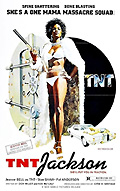 Another major female blaxploitation star was voluptuous
Tamara Dobson, who portrayed a female, undercover 'James Bond-like'
US narcotics agent in Jack Starrett's blaxploitation crime thriller Cleopatra
Jones (1973), combating poppy fields and the heroin trade run
by an over-the-top female crime-lord "Mommy" (Shelley Winters),
aided by
"Doodlebug" (Antonio Fargas). [Note:
The sequel was
Cleopatra Jones and the Casino of Gold (1975).] Another major female blaxploitation star was voluptuous
Tamara Dobson, who portrayed a female, undercover 'James Bond-like'
US narcotics agent in Jack Starrett's blaxploitation crime thriller Cleopatra
Jones (1973), combating poppy fields and the heroin trade run
by an over-the-top female crime-lord "Mommy" (Shelley Winters),
aided by
"Doodlebug" (Antonio Fargas). [Note:
The sequel was
Cleopatra Jones and the Casino of Gold (1975).]
And former October 1969 Playmate Jeannie Bell starred
in Roger Corman's and New World Pictures' TNT
Jackson (1974) -
a merging of kung fu and blaxploitation, in a plot about a karate
expert (Diana 'T.N.T.' Jackson) searching for her brother in a section
of Hong Kong known as "Yellow Town." Its tagline was:
"SHE'S A ONE MAMA MASSACRE SQUAD." In the action thriller's
most remembered scene, TNT was captured and confronted
by drug-dealing mobster Ming (Max Alvarado), who threatened to burn
her bare chest with his cigar, but then changed his mind ("Such
a waste! Perhaps this will not be necessary"). She was able to
escape, turned off the lights, and - while completely topless with
only panties (that changed color) - fought off a darkened room full
of male criminals after taunting them: "You
want it black? You got it black."
The Lasting Influence of Blaxploitation Films:
The success of blaxploitation films brought some opportunities
for blacks in the industry to work in Hollywood, although the vast
majority of these films were still distributed, produced, and controlled
by non-blacks. It also led to an onslaught of other black exploitation
genres, blending the black urban tales with other genres. In the horror
genre in particular, blaxploitation films in the 70s set the stage
for "urban horror" in the ‘90s, with films such as
Def by Temptation (1990), Wes Craven's The People Under the Stairs
(1991), Candyman (1992), and Tales from the Hood (1995).
What also followed
were numerous remakes or lesser imitations ranging from black westerns
to martial arts/kung fu films to horror, drama and gangster films.
The cinematic blaxploitation craze weakened and substantially
died in the mid-to-late 1970s, but then experienced a slight revival
in the 1990s, with Keenen Ivory Wayan's parody film I'm
Gonna Git You Sucka (1988), star/director Eddie Murphy's Harlem
Nights (1989), Mario Van Peebles' New Jack City (1991) and
black western Posse (1993), and Larry Cohen's Original
Gangstas (1996), reuniting stars from the earlier era including
Fred Williamson, Jim Brown, Pam Grier, Ron O'Neal, and Richard Roundtree.
Grier also starred in Quentin Tarantino's homage to the period - Jackie
Brown (1998), and Samuel Jackson appeared in black director John
Singleton's remake Shaft (2000).
In retrospect, all of the blaxploitation films set
the stage for future directors such as Spike Lee, John Singleton,
and F. Gary Gray, and future stars such as Richard Pryor. For example,
director Michael Schultz' entertaining urban comedy Car Wash (1976),
with a script by Joel Schumacher, was a look at a day-in-the-life
of the Los Angeles Dee-Lux car wash, starring Richard Pryor and other
rising black stars. It was followed by Schultz' similar farce Which
Way is Up? (1977) also with Richard Pryor (in a triple role).
The movement also contributed to the rise of Hip Hop
music, influenced fashion, aided the development of the rap subculture,
and produced other movies like the Beverly Hills Cop series
and Pulp
Fiction (1994).
Other Offshoots:
Inevitably, as blaxploitation films disappeared, alternative
African-American films emerged, including other kinds of action films,
comedy, and social dramas. Two black
films more in the mainstream included 20th Century Fox's and blacklisted
director John Berry's romantic drama Claudine
(1974),
starring Best Actress Oscar-nominated Diahann Carroll as the 36 year-old
title character Claudine Price - an unwed and poor Harlem resident
in the early 1970s who was on welfare with six children - and illegally
on the side was a domestic maid. Her romance with
garbage collector Roop (a young James Earl Jones) turned problematic
for many reasons. Also popular was Paramount's Mahogany
(1975),
directed by Motown music chief Berry Gordy. It was the perfect cinematic
vehicle for The Supremes' singer Diana Ross as an aspiring
fashion designer named Tracy living on the South
side of Chicago. It was nominated for an Academy Award for Best Original
Song ("Theme
from Mahogany (Do You Know Where You're Going To)").
Changes in the Ratings System: The Dawn of the X Rating
Major changes in the Production Code had already occurred
in the previous decade when the Motion Picture Production Code was
replaced by a ratings system in 1968. This 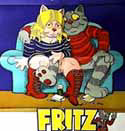 culminated
in the X-rated Best Picture win for Midnight
Cowboy (1969). The movie ratings system was modified in 1970,
replacing the "M" rating
with PG (meaning parental guidance suggested), and redefining "R" (as
at least 17 years or older, unless accompanied by parent or adult
guardian). "X"
rated films were limited to eighteen year olds and above. The first
PG-rated Disney Studios film was The Black Hole (1979),
the studio's most costly film to date. The first X-rated, adult-oriented,
full-length animated cartoon was Ralph Bakshi's cult favorite Fritz
the Cat (1972)
- the lusty adventures of an anthropomorphic, dope-smoking tomcat
named Fritz, a character originally created by Robert Crumb. It
was also the first independent animated film to gross more than
$100 million at the box office. culminated
in the X-rated Best Picture win for Midnight
Cowboy (1969). The movie ratings system was modified in 1970,
replacing the "M" rating
with PG (meaning parental guidance suggested), and redefining "R" (as
at least 17 years or older, unless accompanied by parent or adult
guardian). "X"
rated films were limited to eighteen year olds and above. The first
PG-rated Disney Studios film was The Black Hole (1979),
the studio's most costly film to date. The first X-rated, adult-oriented,
full-length animated cartoon was Ralph Bakshi's cult favorite Fritz
the Cat (1972)
- the lusty adventures of an anthropomorphic, dope-smoking tomcat
named Fritz, a character originally created by Robert Crumb. It
was also the first independent animated film to gross more than
$100 million at the box office.
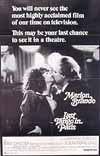 Italian
director Bernardo Bertolucci released the controversial, landmark X-rated
Last Tango in Paris (1972) with a number of sexually explicit scenes.
A year after his portrayal of a puffy-cheeked, Mafioso don, Marlon Brando
played Paul, a grieving, middle-aged widower who embarked on an anonymous
yet passionate sexual relationship with a young French student (Maria
Schneider) - although they never told each other their names. The film,
which won Brando a seventh Oscar nomination, was declared obscene by an
Italian court in 1976. And French director Louis Malle's first
English-language feature film was the provocative Pretty Baby (1978),
featuring nymphette Brooke Shields as a 12 year-old - the daughter of
prostitute Susan Sarandon - being raised in a pre-WWI-era New Orleans
brothel. Italian
director Bernardo Bertolucci released the controversial, landmark X-rated
Last Tango in Paris (1972) with a number of sexually explicit scenes.
A year after his portrayal of a puffy-cheeked, Mafioso don, Marlon Brando
played Paul, a grieving, middle-aged widower who embarked on an anonymous
yet passionate sexual relationship with a young French student (Maria
Schneider) - although they never told each other their names. The film,
which won Brando a seventh Oscar nomination, was declared obscene by an
Italian court in 1976. And French director Louis Malle's first
English-language feature film was the provocative Pretty Baby (1978),
featuring nymphette Brooke Shields as a 12 year-old - the daughter of
prostitute Susan Sarandon - being raised in a pre-WWI-era New Orleans
brothel.
Mike Nichols' Carnal Knowledge (1971) was declared
obscene by a 1971 Georgia ruling and banned in some areas of the country
for its frank exploration of the sexual attitudes and problems of two
modern Americans (Jack Nicholson as Jonathan and Art Garfunkel as Sandy),
from their days as college roommates through middle-age. The Supreme Court
overturned the state's ruling in 1974. William Friedkin's The Boys
in the Band (1970) broke a Hollywood film barrier by honestly dealing
with the subject of homosexuality. Jane Fonda won the Best Actress Oscar
for Klute (1971) for her performance as Bree, a prostitute who
was stalked by a psychopath. The last name of a small-town detective (Donald
Sutherland) who investigated the disappearance of a friend and became
involved with Bree, was Klute!
Pornography became a mainstream, legitimate curiosity
with the screening of Gerard Damiano's exploitation fantasy Deep Throat
(1972) with Linda Lovelace, although the film generated legal actions
and challenges in many localities. Its initial, low-budget investment
of $24,000 brought in receipts totalling at least $20 million (before
the rental and video markets' profits), easily making it the most successful
pornographic film of all-time. A soft-core X (or R)-rated series of films
with abundant erotic nudity also came to US screens from France, beginning
with Just Jaeckin's Emmanuelle (1974), starring Dutch-born actress
Sylvia Kristel, and followed by the equally provocative, well-photographed
sequel by Francis Giacobetti titled Emmanuelle, The Joys of a Woman
(1975).
 It
has often been falsely claimed that the producers of an R-rated sex
comedy, The Happy Hooker
(1975), based on the book of memoirs by legendary New York madam
Xaviera Hollander (portrayed by Lynn Redgrave), were sued by the Walt
Disney Company for using the Mickey Mouse Club theme song during
a group sex scene. In fact, a hard-core X-rated porn film titled The
Life and Times of Xaviera Hollander (1974) (aka The Life and Times of
a Happy Hooker) (starring Xaviera Hollander as the narrator,
and also the notorious John Holmes) was the one whose makers were sued
- they used the Mickey Mouse Club theme song in an explicit orgy scene.
It was set in a game room with a pool table, where three nude males wearing
Mickey Mouse ear-hats first sang the theme song, and then the redhaired
Happy Hooker (Samatha (sic) McClearn) had sex atop the pool table with
one of the men, to the slow, guitar-strummed tune of the theme song.
Then, she engaged with all three - "a triple trick" -
a birthday present bought by a rich father for his son and two friends. It
has often been falsely claimed that the producers of an R-rated sex
comedy, The Happy Hooker
(1975), based on the book of memoirs by legendary New York madam
Xaviera Hollander (portrayed by Lynn Redgrave), were sued by the Walt
Disney Company for using the Mickey Mouse Club theme song during
a group sex scene. In fact, a hard-core X-rated porn film titled The
Life and Times of Xaviera Hollander (1974) (aka The Life and Times of
a Happy Hooker) (starring Xaviera Hollander as the narrator,
and also the notorious John Holmes) was the one whose makers were sued
- they used the Mickey Mouse Club theme song in an explicit orgy scene.
It was set in a game room with a pool table, where three nude males wearing
Mickey Mouse ear-hats first sang the theme song, and then the redhaired
Happy Hooker (Samatha (sic) McClearn) had sex atop the pool table with
one of the men, to the slow, guitar-strummed tune of the theme song.
Then, she engaged with all three - "a triple trick" -
a birthday present bought by a rich father for his son and two friends.
British
director Stanley Kubrick faithfully adapted Anthony Burgess'
novel for his X-rated A Clockwork Orange (1971,
UK) about
juvenile droogs (led by Malcolm McDowell as Alex) on a rampage. The
Warner Bros. film was a violent, perceptive dark satire of the future
that juxtaposed rape and brutality to classical music and the euphoric
tune Singin'
in the Rain. Kubrick was forced to re-edit the controversial
film in order to receive an R-rating. Soon after the
film's release, Kubrick withdrew it from distribution
in the UK to effectively suppress its exhibition after
copycat violence.
Woody Allen's Comedic Era:
 Brooklyn-born,
stand-up comedian Woody Allen joined the ranks of the young new directors
of the 'New Hollywood', beginning his rise as a screenwriter on What's
New, Pussycat? (1965) and work as an actor in What's Up, Tiger
Lily? (1966) (his first film) - the redubbing of a James
Bond-like Japanese action film. He also acted as Bond's nephew in Casino
Royale (1967), plus took an acting and writing role in Play
It Again, Sam (1972) based upon Allen's own 1970 play. He
also appeared as actor, writer and director in the makeshift Take
the Money and Run (1969) (his directorial
debut film) - a
mad-cap, farcical mock-documentary spoof of traditional
gangster films, with Allen portraying an inept, would-be
thief. His second uninhibited, satirical political
comedy, Bananas
(1971) was about a meek products tester in
a factory who departed for South America and accidentally
became a heroic revolutionary dictator. Brooklyn-born,
stand-up comedian Woody Allen joined the ranks of the young new directors
of the 'New Hollywood', beginning his rise as a screenwriter on What's
New, Pussycat? (1965) and work as an actor in What's Up, Tiger
Lily? (1966) (his first film) - the redubbing of a James
Bond-like Japanese action film. He also acted as Bond's nephew in Casino
Royale (1967), plus took an acting and writing role in Play
It Again, Sam (1972) based upon Allen's own 1970 play. He
also appeared as actor, writer and director in the makeshift Take
the Money and Run (1969) (his directorial
debut film) - a
mad-cap, farcical mock-documentary spoof of traditional
gangster films, with Allen portraying an inept, would-be
thief. His second uninhibited, satirical political
comedy, Bananas
(1971) was about a meek products tester in
a factory who departed for South America and accidentally
became a heroic revolutionary dictator.
His next three films were also comedies. 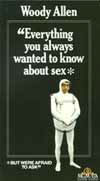 Humorous
sketches in Everything You Always Wanted to Know About Sex But
Were Afraid to Ask (1972) dramatized the contents of David Reuben's
popular sex manual, covering topics such as public sex, perversion,
and ejaculation. Two of his best early films, with his typical collection
of sight gags and witty jokes were Play it
Again, Sam (1972), a film
version of Allen's own play about a crushed film
critic who took romantic advice from an imaginary Humphrey Bogart,
and the futuristic, wacky sci-fi spoof and Rip Van Winkle tale set
in the year 2173, Sleeper
(1973) - the first Allen-directed film
with ex-real-life love interest Diane
Keaton. Love
and Death (1975) spoofed Tolstoy's Russian
novel
War and Peace, and was a parody of films by
Bergman and Eisenstein. Humorous
sketches in Everything You Always Wanted to Know About Sex But
Were Afraid to Ask (1972) dramatized the contents of David Reuben's
popular sex manual, covering topics such as public sex, perversion,
and ejaculation. Two of his best early films, with his typical collection
of sight gags and witty jokes were Play it
Again, Sam (1972), a film
version of Allen's own play about a crushed film
critic who took romantic advice from an imaginary Humphrey Bogart,
and the futuristic, wacky sci-fi spoof and Rip Van Winkle tale set
in the year 2173, Sleeper
(1973) - the first Allen-directed film
with ex-real-life love interest Diane
Keaton. Love
and Death (1975) spoofed Tolstoy's Russian
novel
War and Peace, and was a parody of films by
Bergman and Eisenstein.
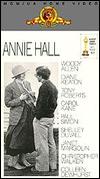 As
the decade progressed, Woody Allen's major breakthrough triumph was a
semi-autobiographical, bittersweet and poignant love story/comedy Annie
Hall (1977), with Oscar-winning Best Actress Diane Keaton as the
tomboyish, kooky, and nervous title character (noted for saying: "La-di-da,
la-di-da") in a relationship with the urban neurotic Allen (as New
York Jewish comedian Alvy Singer). The ditzy ingenue's impromptu, man-tailored
wardrobe costumes influenced fashion trends, and the self-reflexive, kaleidoscopic film contained a variety of innovative strategies and narrative techniques, including animation, subtitles, split-screens, direct addresses to the camera breaking the 4th wall, the instant appearance of Marshall McLuhan to refute a statement ("If life were only like this"), etc. The influential film awarded Allen
with top accolades including the year's Best Picture (defeating Star
Wars (1977)), Best Director and Best Original Screenplay (Marshall
Brickman and Woody Allen) Awards. Originally titled Anhedonia,
it was severely edited down from a 2.5 hour rough cut to its present 93-minute
length. As
the decade progressed, Woody Allen's major breakthrough triumph was a
semi-autobiographical, bittersweet and poignant love story/comedy Annie
Hall (1977), with Oscar-winning Best Actress Diane Keaton as the
tomboyish, kooky, and nervous title character (noted for saying: "La-di-da,
la-di-da") in a relationship with the urban neurotic Allen (as New
York Jewish comedian Alvy Singer). The ditzy ingenue's impromptu, man-tailored
wardrobe costumes influenced fashion trends, and the self-reflexive, kaleidoscopic film contained a variety of innovative strategies and narrative techniques, including animation, subtitles, split-screens, direct addresses to the camera breaking the 4th wall, the instant appearance of Marshall McLuhan to refute a statement ("If life were only like this"), etc. The influential film awarded Allen
with top accolades including the year's Best Picture (defeating Star
Wars (1977)), Best Director and Best Original Screenplay (Marshall
Brickman and Woody Allen) Awards. Originally titled Anhedonia,
it was severely edited down from a 2.5 hour rough cut to its present 93-minute
length.
Turning more serious and introspective, Allen directed
the somber Interiors (1978) - a film with Bergman-esque qualities.
The film, a portrait of a family's disintegration, was less well-received.
At the conclusion of the decade, Allen directed and starred in another
of his best, most accomplished and deepest films, Manhattan
(1979)
- one of his biggest hits to date. It was a beautifully-photographed
black-and-white, sardonic comedy about a group
of sophisticated but neurotic Manhattanites
with their attendant foibles, loves, angsts,
and frustrations in the search for happiness
and fulfillment. The film, filled with George
Gershwin music, featured Allen as a 42 year-old
comedy writer in a relationship with a 17 year-old
high-school student (Mariel Hemingway) in his
most favorite hometown. At the end of the decade,
he directed the autobiographical Stardust
Memories (1980), about
a successful director who suffered a mid-life
crisis.
 Film History of the 1970s
Film History of the 1970s
Part 1, Part 2, Part 3, Part 4, Part 5, Part 6

 
|
